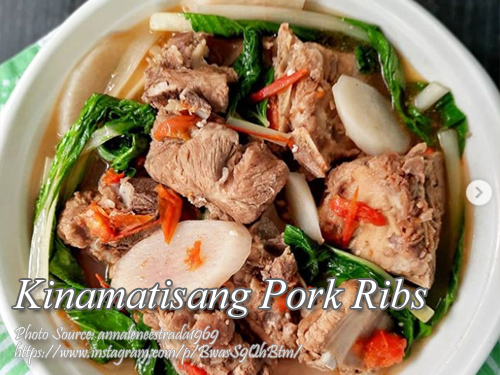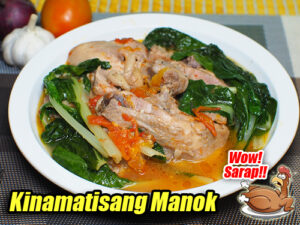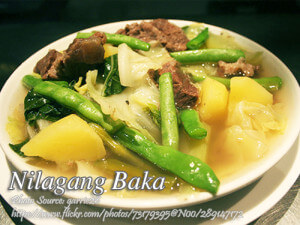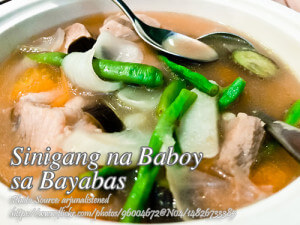If you are looking for an alternative to pork sinigang, then I think this kinamatisang pork ribs is the one you are looking for. They are quite similar because the broth has a souring agent. But unlike sinigang, this dish is using ripe tomatoes instead of tamarind. But usually its not as sour as sinigang and it is more of a nilagang baboy.
It is something in between and the flavor is just right. The dish is a pork bone soup prepared by slowly simmering the bony pork cuts until tender and combined with white radish (Daikon), pechay, garlic and onions and a generous amount of tomatoes.
Kinamatisang Pork Ribs: A Bowl of Comfort and Family Memories
When I think about comfort food that warms both the stomach and the soul, kinamatisang pork ribs always comes to mind. Growing up in Laguna, this was one of those dishes that seemed to appear on the table whenever the weather turned gloomy or when family gathered on lazy Sundays. My Tita Lourdes used to say that a pot of simmering pork bones with tomatoes could cure almost anything—sad moods, tired bodies, or even just a long week at work. She was right. This dish isn’t just about flavor; it’s about memory and the people you share it with.
A Cross Between Nilaga and Sinigang
If you’ve ever tried sinigang, you’ll notice some similarities right away. Both dishes have a tangy broth that wakes up the appetite. But unlike sinigang, which is usually sharpened by tamarind, kinamatisang pork ribs relies on ripe tomatoes to bring that mild sourness. It’s not as puckering as sinigang, but not as neutral as nilagang baboy either. It sits perfectly in between—balanced, mellow, and incredibly satisfying.
My Kuya Edgar, who once worked in Quezon, told me that the locals there often preferred this version when they wanted a break from the more sour tamarind-based soups. He brought the idea home, and ever since then, it became our family’s go-to whenever tomatoes in the backyard ripened faster than we could eat them.
The Heart of the Dish: Tomatoes and Bones
The real charm of this soup lies in the tomatoes. By sautéing them first with onions and garlic, they soften and release their juices, creating a natural base that flavors the broth deeply. It’s one of those simple cooking techniques that may seem small but makes all the difference.
Then there are the pork ribs. Using bony cuts is key here. As they simmer slowly, the bones release collagen, which gives the broth a rich body and a slightly silky texture. My Lolo Ernesto used to say that you’ll know it’s cooked perfectly when the meat slides off the bone with just a gentle tug of the fork. That’s when you’re rewarded with a soup that feels nourishing and hearty without being too heavy.
Cooking Kinamatisang Pork Ribs the Right Way
The process is straightforward, which is why it’s perfect for beginners in the kitchen. You start by sautéing garlic and onions until they’re fragrant, then in go the tomatoes and a splash of patis to draw out even more flavor. Covering the pot while the tomatoes cook helps them break down faster, almost melting into the oil and seasonings.
When you add the ribs, you give them a quick sear until their pink color turns pale. This step is important—it locks in the flavor of the meat before it joins the broth. Pouring in water at this stage and letting it simmer patiently is where the magic happens. Twenty minutes might feel long, but it’s exactly what you need to coax out all the richness from the bones.
Adding the daikon radish halfway through not only brings sweetness but also absorbs the flavors of the broth beautifully. Finally, pechay goes in at the very last minute so it stays crisp and green, adding freshness to the bowl. Each ingredient plays its part, and together they make a soup that feels complete.
A Dish with Roots
Kinamatisang pork ribs might not have the same widespread fame as sinigang, but its roots run deep in Filipino kitchens. It reflects the resourcefulness of using what’s on hand—whether it’s ripe tomatoes from the garden or inexpensive cuts of pork. Some food historians even suggest that this dish represents the Filipino palate’s love for balanced flavors: not too sour, not too bland, but just right.
Back in the day, my Lola would prepare a big pot and leave it on the wooden table, covered with just a wide plate on top. Anyone who came home—whether it was cousins from school or uncles returning from work—could ladle out a bowl and feel instantly comforted. That’s the kind of dish this is, humble but full of heart.
Bringing It to Your Table
If you’re looking for something simple yet deeply satisfying, this soup is worth trying. The steps are easy, the ingredients are affordable, and the results are always rewarding. Pair it with steaming white rice, maybe a little patis with calamansi on the side, and you’ll understand why it’s a family favorite in so many Filipino homes.
Every time I cook kinamatisang pork ribs, I remember the laughter in my grandmother’s kitchen, the smell of garlic frying, and the sight of my cousins fighting over the biggest rib in the pot. Try it once, and I’m sure it will bring a taste of home to your own table too.
Frequently Asked Questions:
Can I use other cuts of pork instead of ribs?
Yes, you can substitute pork ribs with other bony cuts like pork neck bones or pork shank. These cuts also release rich flavors into the broth and make the soup hearty. Just avoid very lean cuts since they can dry out and won’t give the same depth.
What vegetables can I add to kinamatisang pork ribs?
Aside from radish and pechay, you can also add cabbage, sitaw (string beans), or even talong (eggplant). Each adds a different texture and flavor to the soup. The key is to add them at the right stage so they don’t overcook.
How do I keep the broth clear and flavorful?
Skim off the scum that rises to the surface during the first few minutes of boiling the ribs. This keeps the broth clean and enhances its taste. Cooking low and slow also helps extract flavor without making the soup cloudy.
How to Cook Kinamatisang Pork Ribs
Ingredients
- 1 kilo pork ribs
- 3/4 kilo very ripe tomatoes chopped
- 2 pcs white onions chopped
- 2 to 3 cloves garlic minced
- 1 tsp. salt
- 1 piece white radish sliced diagonally
- 2 bunches pechay
- 1 Tbsp. patis
- 1/4 cup cooking oil
Instructions
How to Cook Kinamatisang Pork Ribs
- Heat cooking oil in a wok or pot over medium heat. Saute onions, and garlic until the onion is tender.
- Add in the tomatoes and saute for a minute then pour patis. Then cover and simmer until the tomatoes are tender.
- Add the pork ribs and saute until the pork changes color. Cook for about 3 to 5 minutes.
- Add 1.5 liters water and bring to a boil. Lower heat and cover. Simmer for 20 minutes or until meat is fork tender.
- Add in the radish and simmer for 10 more minutes.
- Before serving, add pechay and let it cook for 1 to 2 minutes and season with salt if needed. Serve hot.
Video
Notes
Cooking Tips:
Use Ripe Tomatoes for Depth of Flavor
Choose fully ripe and juicy tomatoes to give the broth its natural sweetness and tang. Unripe ones will make the soup taste flat, while overripe tomatoes might turn mushy too quickly. If you want a richer flavor, you can roast the tomatoes before adding them to the pot.Simmer the Ribs Low and Slow
Allow the pork ribs to cook gently over low heat to release their natural flavors and collagen. This technique not only tenderizes the meat but also gives the broth a silky, comforting texture. Rushing the process will result in tough ribs and a thinner-tasting soup.Add the Vegetables at the Right Time
Radish needs more time to soften, so it should go into the pot earlier, while pechay should be added last to keep its freshness and crunch. This timing makes each vegetable shine in the dish without turning soggy. Balancing their cooking time ensures your kinamatisang pork ribs stays colorful, hearty, and appetizing.





